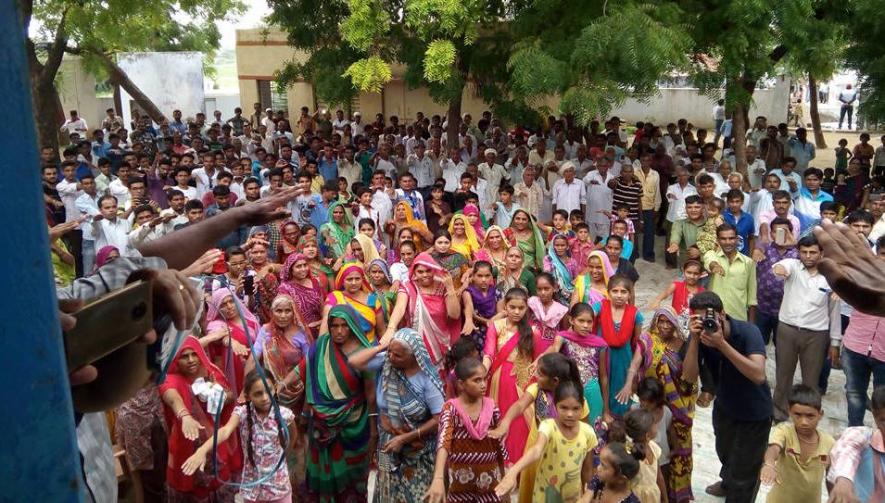Gujarat: The Azadi Kooch March and Land Reform

Dalits taking a pledge to end the caste-based practice of disposing dead cattle in Dholka block, Ahmedabad district, Gujarat. Image Courtesy: Jignesh Mevani
A historic movement of Dalits is unfolding in the State of Gujarat in India. This movement, led by young Dalit leaders like Jignesh Mevani, emerged after the incident at Una in Gir Somnath district, where seven Dalit men were assaulted with iron rods for allegedly skinning a dead cow. These men suffered serious injuries, and four of them were further humiliated by parading them in the town.
The Una incident initiated a state-wide protest movement of Dalits. A long march – the Azadi Kooch March – is being planned by the movement in August 2016 from Ahmedabad to Una. A marked feature of this movement is also the wide-ranging nature of its demands. Justice to the victims of Una is one of the demands, of course, but the movement has also demanded the urgent implementation of land reforms. Speaking to SabrangIndia and Newsclick, Mevani said:
In Gujarat, the Gujarat Land Ceilings Act and the Government’s agricultural policy have provisions to apportion 5 acres each of land to Gujarat’s Dalit families. This must be done. Immediately. Brooking no further delay. A government that can grant land, virtually free or gratis to the Adanis, Ambanis, and Essar can surely grant land to Gujarat’s Dalits? This is a social revolution for Dalit’s economic upliftment.
Mevani also said: “We appeal to all Indians, democratic and secular, be they Gandhian, Communist, feminists, or from non-governmental organizations, to join this movement for upliftment and emancipation.”
In this context, it is useful to examine how successive Congress and Bharatiya Janata Party (BJP) governments in Gujarat have weakened land reform laws and gifted away thousands of acres of surplus and waste land, to be redistributed to the landless, including Dalits, to private firms close to the ruling class. A more detailed analysis is in a paper I wrote for ‘The Marxist’ in 2014, but here are some salient points from the article.
Until the late 1980s, land reform in Gujarat was guided by a set of laws enacted from the 1940s onwards. Outside the Saurashtra region, which had its own land reform legislation, the rest of the State was governed by the Bombay Tenancy and Agricultural Land Act, 1948. A number of changes were made to the existing legislation by Congress and BJP governments in order to free up land markets and facilitate the private takeover of large tracts of land (see Sud, 2014).
Dalits taking a pledge to end the caste-based practice of disposing dead cattle in Dholka block, Ahmedabad district, Gujarat. This image is taken from Jignesh Mevani’s Facebook page.
First, in 1987, the Congress government withdrew Section 2(6) of the Bombay Tenancy and Agricultural Land Rules. Section 2(6) disallowed any person from buying or or selling agricultural land beyond 8 km from one’s residence. The clause was intended to discourage absentee landlordism. Under the amended law, any person could buy agricultural land anywhere in the State. Initially, this was applicable only to drought-affected regions; in 1995, the amended law was implemented across the State. The Congress government justified the amendment and stated that it would “facilitate mobility and entrepreneurship” (Sud, 2014, p. 238).
Secondly, in 1995, the BJP government introduced an amendment to Section 65 of the Bombay Land Revenue Act. This amendment removed all restrictions on the conversion of agricultural land to non-agricultural land. Suresh Mehta, the Industries Minister, called this move “revolutionary” (Sud, 2014, p. 238). However, within Gujarat, the move was criticised immediately (see Ramachandran and Ramakumar, 2000). A former Commissioner of Land Reforms in the State was reported to have said that it was an attempt by the BJP Government to bring back the Zamindari system, “depriving poor farmers of their land holdings and reducing them to the level of landless labourers” (Dasgupta, 1995). He said that the measure “would not only reduce the cultivable land area, but would also affect the rural economy seriously and increase the number of people living below the poverty line” (ibid.).
A Gujarat correspondent of The Hindu wrote that:
Politicians and experts are surprised at the speed with which the BJP intends to rush through a measure to abolish all restrictions on land sharks and big industrial houses from grabbing agricultural land… [From] the way the draft bill was circulated among members, it is clear that the exercise was taken up by the BJP from day one after the swearing-in ceremony of the new Cabinet, apparently under heavy political pressure from influential land sharks and business houses. It is learnt that the party has been promised liberal financial assistance towards its election funds for the coming parliamentary elections if the restrictions on land purchase were withdrawn promptly by the State Government (cited in Ramachandran and Ramakumar, 2000).
Thirdly, a New Land Policy was approved by the BJP government in 1996 (Sud, 2014). All beneficiaries of land reforms in the 1960s and 1970s and beneficiaries of waste land development schemes were provided with “new tenure” (navi sharat), under which land was not saleable. The new policy allowed people holding navi sharat over land for 15 years to convert it to the old form of tenure (juni sharat) and become eligible to sell it. The change of tenurial status allowed industry to buy land freely from navi sharat holders and use it for non-agricultural purposes. Nikita Sud writes that in 2003, after Narendra Modi became Chief Minister, land policy was further liberalised and all navi sharatlands were automatically and immediately converted to juni sharat lands. All requirements to obtain permission to sell land were waived.
Fourthly, in 2005, the government allowed gauchar land or village common land and all wasteland to be sold to industry for non-agricultural uses. According to Sud (2014), the 2005 amendment transferred about 46 lakh hectares of state-controlled wasteland to industrial houses to establish industries or introduce corporate farming. Wherever wastelands were suitable for cultivation, a private individual or entity was provided up to 2000 acres of land for 20 years, of which the first five years were rent-free; for the remaining period, the rent was fixed at Rs 40-100 per acre.
Thus, in the 1990s and 2000s, the Congress and BJP governments in Gujarat facilitated the transfer of lakhs of hectares of agricultural and public land to industrial houses at cheap rates. In 2014, there were around 60 Special Economic Zones (SEZ) in Gujarat, covering an area of approximately 27,125 hectares of land acquired under the new land regulations. This had two consequences. First, such policies significantly reduced the extent of land that could have been allotted to landless agricultural workers and small peasants as part of a continuing land reform programme. Secondly, hundreds of crores worth of public assets were gifted away to private corporate aggrandisement. Writing on such social bribery through land transfers, Sud wrote:
…land has been deregulated in Gujarat in order to facilitate an open market. However, in the face of continued imperfections and power imbalances, the state quite openly takes sides in the land market and in the process continues to be a key player in the economy of a liberalized resource…Institutions of the state, ranging from government departments to local councils, are involved in deft manoeuvring between market- and business-friendly practices, both legal and extra-legal. (Sud, 2014, p. 239)
It is in this context that the Una agitation has to be seen. Will the movement lead to a convergence of all forces that can reignite the movement for land reform in Gujarat? Only time will tell, but the signs are promising.
References
Dasgupta, Manas (1995), “Gujarat Land Reform Bill under Fire”, The Hindu, Chennai, Mar 30.
Ramachandran, V. K. and Ramakumar, R. (2000), “Agrarian Reforms and Rural Development Policies in India: A Note”, Paper presented at the International Conference on Agrarian Reform and Rural Development, Government of the Philippines and the Philippines Development Academy, Tagaytay City, Philippines, December 5 to 8.
Sud, Nikita (2014), “The State in the Era of India’s Sub-national Regions: Liberalization and Land in Gujarat”,Geoforum, 51, pp. 233-242.
Get the latest reports & analysis with people's perspective on Protests, movements & deep analytical videos, discussions of the current affairs in your Telegram app. Subscribe to NewsClick's Telegram channel & get Real-Time updates on stories, as they get published on our website.
























